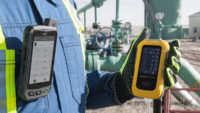From NIOSH:
Freestanding mast-climbing work platform remains stable during fall arrest, if properly used

The mast climber, pictured above, remained stable and upright in different test scenarios when used according to the manufacturer’s instructions. Photo from NIOSH.
If you have seen a construction site recently, you may have noticed workers standing on elevated equipment that resembles scaffolding, except with only one platform level for workers. With its ship-like mast, this equipment is aptly called a mast-climbing work platform, or mast climber for short.
Unlike traditional scaffolding anchored on the side of a building or other structure, mast climbers can be either anchored or freestanding. They offer several advantages over traditional scaffolding, including the ability to reach greater heights, hold heavier loads, and configure form to fit a particular work site. These advantages have led to wider use of mast climbers throughout the construction industry, even as their potential safety risks to workers remain unclear. At NIOSH, engineers study these risks and the best ways to prevent them.
Of particular concern is the mast climber’s stability during a fall event. To prevent falls, the Occupational Safety and Health Administration requires mast climbers and other types of scaffolding to have guardrails or personal fall-arrest systems. Personal fall-arrest systems comprise a wearable harness anchored to the mast climber to stop a worker from falling.
NIOSH engineers recently tested the stability of a freestanding mast climber in different scenarios. These scenarios tested fall arrest with a life-size dummy wearing a personal fall-arrest system under differing configurations of platform load. Their findings, published in the Journal of Safety Research, showed that when properly assembled according to manufacturer’s instructions the mast climber remained stable and upright. At the same time, however, the results showed that workers near an open edge without a personal fall-arrest system could be injured when another worker on the platform has a fall arrest incident. According to the engineers, these workers also should wear personal fall-arrest systems when near open edges on the platform to protect them from being shaken or knocked off the mast climber during a fall incident. Further research is necessary to understand other potential safety risks of mast climbers, according to the engineers.
More information is available:
Looking for a reprint of this article?
From high-res PDFs to custom plaques, order your copy today!




